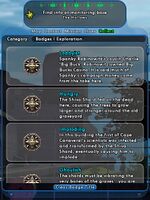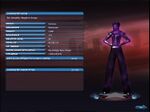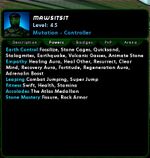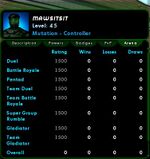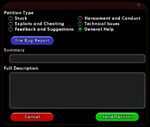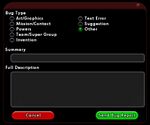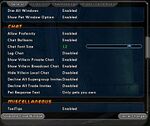The Players' Guide to the Cities/User Interface: Difference between revisions
imported>Eabrace (historical) m (→Map Window: trim) |
imported>Eabrace (historical) m (→Windows: minor corrections) |
||
| Line 9: | Line 9: | ||
Some child windows can be released from their parents and allowed to float. Floating windows may be dragged to new locations and can often be enlarged to display more detail or shrunk to be placed off to the side where they will serve as information, but not interfere with your interaction with the world. In addition, a window that is floating can be opened and closed independently of the child windows belonging to the same parent window. | Some child windows can be released from their parents and allowed to float. Floating windows may be dragged to new locations and can often be enlarged to display more detail or shrunk to be placed off to the side where they will serve as information, but not interfere with your interaction with the world. In addition, a window that is floating can be opened and closed independently of the child windows belonging to the same parent window. | ||
For example, if the Map Window is anchored to the Nav Window, moving one will move the other. If you have the Map Window open and decide to open the Badges Window (which, in this example we will assume is also anchored), the Map Window will close and the Badges Window will open. However, if the Map Window is floating and you decide to open the | For example, if the Map Window is anchored to the Nav Window, moving one will move the other. If you have the Map Window open and decide to open the Badges Window (which, in this example we will assume is also anchored), the Map Window will close and the Badges Window will open. However, if the Map Window is floating and you decide to open the Badge Window, doing so will not close the Map Window. Similarly, if the Map Window is set to float and the Badge Window is currently open, opening the Map Window will not close the Badge Window. | ||
In order to set a child window to float, click on the bubble in the upper or lower left corner of the child. If the bubble is filled, the window will be anchored. If the bubble is empty, the window is floating. | In order to set a child window to float, click on the bubble in the upper or lower left corner of the child. If the bubble is filled, the window will be anchored. If the bubble is empty, the window is floating. | ||
Revision as of 15:18, 9 August 2007
< [[../|Main Table of Contents]]
Windows
There are several windows that you may display in your user interface that will aid in navigating through the game, surviving your encounters, and communicating with other players.
Several of these windows display general information and are able to spawn other windows with more detailed information. This may be done by clicking on the name of the child window you wish to open. You may then close the child window by clicking on the name of the window again. You may also close these windows by clicking on the small red 'X' bubble in either the lower or upper right hand corner of the window.
Often, these child windows are attached to their parent by default and will move with the parent window. When anchored to parent windows, opening a second child window from the same parent will close the first child window.
Some child windows can be released from their parents and allowed to float. Floating windows may be dragged to new locations and can often be enlarged to display more detail or shrunk to be placed off to the side where they will serve as information, but not interfere with your interaction with the world. In addition, a window that is floating can be opened and closed independently of the child windows belonging to the same parent window.
For example, if the Map Window is anchored to the Nav Window, moving one will move the other. If you have the Map Window open and decide to open the Badges Window (which, in this example we will assume is also anchored), the Map Window will close and the Badges Window will open. However, if the Map Window is floating and you decide to open the Badge Window, doing so will not close the Map Window. Similarly, if the Map Window is set to float and the Badge Window is currently open, opening the Map Window will not close the Badge Window.
In order to set a child window to float, click on the bubble in the upper or lower left corner of the child. If the bubble is filled, the window will be anchored. If the bubble is empty, the window is floating.
Any window that may be resized can be manipulated by clicking on the outer borders of the window and dragging them to make the window the right size.
Clicking in the tab on the upper or lower border of any floating window will allow you to drag the window around the screen to reposition it.
In a few cases, windows may have sections within them that may be resized by clicking the borders between sections and dragging them to reallocate space. Columns of information in the Super Group Window and the divider between the upper and lower chat windows in the Chat Window are just two examples of this.
Status Window
Chat Window
Team Window
Search Window
Pets Window
Friends Window
Super Group Window
Email Window
Tray Window
Powers Window
Inspirations Window
Enhancements Window
Salvage Window
Recipes Window
Target Window
Action Window
Map Window
Contact Window
The Contact Window may be opened either by clicking on "Contact" in the Nav Window or selecting "Contact" from the Menu Window.
This window displays a list of all of the contacts you have been introduced to. Each contact in your list will have a picture on the left side of their entry. To the right of the picture will be the name of the contact, the contact's location, and a bar indicating how well you know this contact. Every time you complete a mission for a contact, the bar will fill a little. When you reach a certain level of familiarity with a contact, a "Call" button will appear to the right of the contact's information. Once this button appears, you may speak with this contact from any zone map by clicking on the "Call" button.
If you have an active mission from any contacts, the mission will be shown below the contact's level of familiarity. If you have opened a contact's story arc, a small book icon will be displayed to the right of the contact's name and location.
Most of the time, the contacts in this window will appear in the order in which they were first introduced to you. Newer contacts will appear at the top of your list and older contacts will appear at the bottom of your list. As an exception to this, any contact with whom you currently have a mission active will be pushed to the top of your contact list.
Clicking on any contact in your list will select them as a waypoint in your Nav Window.
After reaching level 5 and speaking with speaking with a Detective, Heroes can obtain a Police Band Radio. Once acquired, the radio will appear in the Contact Window at the top of contact list. Heroes can then click on the radio to pick up Police Band Missions in any zone which is appropriate to their currently level. Each Police Band Mission will fill the familiarity bar of that zone's Detective. Once the Detective's bar is full, you will have to speak directly to the Detective to obtain a Safeguard Mission. When the Safeguard mission is complete, the Detective's familiarity bar will be cleared and you can begin filling it in again.
Similarly, after villains reach level 5 and speak to a Broker, they will obtain a Newspaper. Once a Villain has done this, the Newspaper will appear at the top of the contact list. Villains can then click on the newspaper to pick up Newspaper Missions in any zone appropriate to their level. Each Newspaper Mission will fill the familiarity bar of that zone's Broker. Once the Broker's bar is full, you will have to speak directly to the Broker to obtain a Mayhem Mission. When the Mayhem mission is complete, the Broker's familiarity bar will be cleared and you can begin filling it in again.
Mission Window
The Mission Window may be opened either by clicking on "Mission" in the Nav Window or selecting "Mission" from the Menu Window.
In this window, you can view a brief description of all of the missions you have agreed to undertake. At the top of your list of missions you will see your character's name on the left and current notoriety setting on the right. In each description you will see the mission's primary objective in the upper left, location in the upper right, and the first couple of lines from your contact's briefing. If you click on a mission in this window, it will highlight the mission's entry and a "more..." button will appear in the entry's lower right corner. Click the "more..." button to view the mission's information in full detail. You will be able to view the initial mission briefing, see any progress made so far, and see if you have found any clues.
Selecting any mission in this list will set it as your current waypoint if you are located the same zone as the mission entrance is located.
When you join a team, this window will show you all of the missions any team members in the same zone currently have and will allow you to see each member's notoriety setting. If you are your team's leader, you may select a mission for your team by selecting a mission's description and clicking the "Select Mission" button at the bottom of the Mission Window. This will set the active task set the mission's entrance as a waypoint for all of your team's members.
Clues Window
The Clues Window may be opened by clicking on "Clues" in the Nav Window or selecting "Clues" from the Menu Window.
Depending on the mission, you may need to unearth clues to keep the narrative moving forward. Each time you obtain a new clue, it flashes on the screen and may then be accessed in the "Clues" tab. In this tab is a list of clues you have discovered in the course of your adventures.
Clues provide valuable information that might come in handy for your broker or might point you to the next step in your current mission. This is the key in many cases, as you need to find all clues to fully complete a given mission.
On occasion, certain clues might persist after you've seemingly completed all tasks related to that mission. In that case, the chances are near 100% that there's something you have yet to do that relates directly to that clue--this is why it's important to read all of them when you get them!
Souvenirs are clues you are allowed to keep which provide a historical account of any story arcs you have previously completed. In the "Souvenirs" tab of this window, you will see a list of all the souvenirs you have collected. To view the details of any of these souvenirs, click the ">>" button in the lower right to expand the souvenir's information. To collapse the entry again, click on the "<<" button in the lower right.
Badge Window
You may open the Badge Window by clicking "Badge" in the Nav Window or selecting "Badge" from the Menu Window.
This window shows you all of the badges you currently have and in many cases shows you progress toward other badges.
There are several types of badges, each having its own tab at the top of this window.
- Exploration Badges - Exploration badges are earned simply for finding a location of particular interest. Just traveling through the area will award you with the badge. Locations that award Exploration Badges are marked with an Exploration Badge Marker.
- History Badges - History badges are collected by reading plaques throughout Paragon City and the Rogue Isles. Various plaques are located throughout the game and some relate to one another. By reading all of the plaques related to a particular subject, you can earn a History badge on that subject.
- Accomplishment - Accomplishment badges are awarded for completing certain missions and Task Forces.
- Achievement - Achieving specific goals, such as defeating a large number of a specific enemy type or taking a large amount of damage, can earn these badges. Some of these badges will have a meter showing you your progress toward obtaining the badge.
- Accolades - Most of these badges are earned not by themselves, but by collecting badges in the Exploration, History, Accomplishement, and Achievement areas that all related to one another. Once you have all the badges an Accolade requires, you will be issued the Accolade badge. Some Accolade badges also award your character with extra abilities or permanent boosts to your Hit Points or Endurance. Other Accolades may be awarded for special events or anniversaries in the "City of" franchise.
- Gladiator - Gladiator badges are obtained by accomplishing specific tasks that unlock creatures for use in Arena Gladiator Matches.
- Veteran - For every three months of active subscription to City of Heroes or Villains, your account will be awarded a new Veteran Reward badge. To claim any rewards that are offered along with these badges, click on the "Veteran" tab in your Badge Window. Rewards related to any Veteran Rewards badge will be listed along with the related badge. In the lower right corner of each reward will be a button that you can click to claim your reward.
With the exception of Gladiator badges, clicking on any badge you have obtained will set your character's Badge Title. This title appears under your name when other players are viewing your name above your character's avatar in the game. You may clear your badge title at any time by clicking on the "Clear Badge Title" button at the bottom of the Badge Window.
If you are currently associated with a Super Group, you will also be able to view any badges that have been obtained by your Super Group. At the bottom of the Badge Window you will find a button labeled "Super Group Badges". Clicking on this button will switch you to viewing Super Group badges. All of the same tabs that appear in the personal badges also appear in the Super Group badges, but Super Groups are only able to aquire badges under two categories:
- Exploration - Super Group Exploration badges are earned by visiting all of the Exploration Badge markers in a zone while in Super Group Mode. If you have already collected some of the Exploration Badges in a zone but weren't in Super Group Mode, you merely have to revisit the markers for those badges while in Super Group Mode.
- Achievement - Super Group Achievement badges are rewarded for achieving specific goals, such as defeating a large number of a specific enemy type or taking a large amount of damage. Any work done toward these badges must be done in Super Group Mode in order to count. Some of these badges will have a meter showing you your Super Group's progress toward obtaining the badge.
Menu Window
You may open the Menu Window by clicking on "Menu" on the Status Window or typing "/menu" into the Chat Line. By default, this window may also be opened by pressing the '\' key.
The following windows may be accessed from the Menu Window:
- Chat
- Friends
- Team
- Super Group
- Tray
- Powers
- Inspirations
- Enhancements
- Nav
- Map
- Contacts
- Clue
- Badge
- Target
- Help
- Costume
- I.D.
- Personal Info
- Chat Handle
- Options
- Support
In addition to opening or closing each of the above windows, you may also select "Quit" from the Menu Window to either return to the login screen or quitting to your desktop.
When logging out, you will remain visible and can still be attacked for 30 seconds. If you press any key during this time, the countdown will be aborted and you will not log out. When the countdown reaches zero, you will either be sent back to the login screen.
If quitting to the desktop, you will have the option to quit out of the game before the 30 second timer has expired. If you do this, you will be sent out to the desktop, but your character will remain visible in the game and may still be attacked until the remainder of your 30 second timer has expired.
Help Window
The Help Window may be opened by selecting "Help" from the Menu Window.
This window provides a quick reference for almost everything in the game with topics ranging from Combat to Super Group Base construction. Select a general topic from the tabs at the top of the window. On the left side of the window you will see a list of terms that apply to that topic. Selecting any of these terms will display a more detailed explanation of the term on the right side of the window.
Costume Window
The Costume Window may be opened by selecting "Costume" from the Menu Window.
In this window you will see all of the costume slots you have unlocked, and will be able to switch between costumes for your character's avatar.
I.D. Screen
The I.D. Screen may be accessed by selecting "I.D." from the Menu Window.
On this screen, you can view information about your character, such as:
- Name - The name you chose at character creation with any additional titles you have selected over time.
- Origin - The Origin you chose at character creation.
- Archetype - The Archetype you chose at character creation.
- Super Group Association - The Super Group you are currently affiliated with (if any.)
- Hit Points - Your maximum Hit Points.
- Endurance - Your maximum Endurance.
- Security/Threat Level - Your current level.
- Total XP - The total Experience Points you have accumulated.
- XP Remaining - The amount of Experience Points you need to aquire to reach your next level.
- Influence/Infamy - The amount of Influence or Infamy you currently have to saved.
- Known Powers - A list of all the powers you have selected or earned access to.
- Character Description - Your character's personal biography.
- Battle Cry - Your character's personal catch phrase.
You may return from this screen to the main user interface by clicking on the button in the lower right corner of the I.D. Screen.
Character Description
Your Character Description can be edited at any time by opening the I.D. Screen and editing the Character Description field. If you wish, you may copy from any text document and paste to this window. You are limited to a maximum of 1023 characters (including spaces and carriage returns) in the Character Description field.
Battle Cry
Your character's Battle Cry may be edited at any time by opening the I.D. Screen and editing the Battle Cry field. You are limited to a total of 32 characters (including spaces) in this field. By default, when you press the F10 key on the keyboard, your character will shout out their battle cry and perform the "attack" emote.
Info Window
The Info Window has four main forms and may be opened in several different ways:
- Player Character Info - Displays information about your character or other players' characters.
- Personal Info - Open either by selecting "Personal Info" from the Menu Window or entering "/infoself" in the Chat Line.
- Friendly PC Info Window - Open either by right clicking on a friendly PC and selecting "Info", targeting a friendly PC and selecting "Info" from the Action Window, or targeting a friendly PC and entering "/info" in the Chat Line.
- Enemy PC Info Window - Open either by right clicking on an enemy PC and selecting "Info", targeting an enemy PC and selecting "Info" from the Action Window, or targeting an enemy PC and entering "/info" in the Chat Line.
- Non-Player Character Info - Displays information about Non-Player Characters.
- Enemy NPC Info Window - Open either by right clicking on an enemy NPC and selecting "Info", targeting an enemy NPC and selecting "Info" from the Action Window, or targeting an enemy NPC and entering "/info" in the Chat Line.
- Friendly NPC Info Window - Open either by right clicking on a friendly NPC and selecting "Info", targeting a friendly NPC and selecting "Info" from the Action Window, or targeting a friendly NPC and entering "/info" in the Chat Line.
- Item Information Window - Displays information about various types of items.
- Enhancement Info Window - Open by right clicking on an Enhancement and selecting "Info."
- Salvage Info Window - Open by right clicking on an item in your Salvage Window and selecting "Info."
- Inspiration Info Window - Open by right clicking on an Inspiration in your Inspirations Window and selecting "Info."
- Power Info Window - Displays information about Powers and their effects.
- Power Description Info Window - Open by right clicking on any power icon either in your Tray Window or the Powers Window and selecting "Info."
- Effect Info Window - Open by right clicking on any status icon either outside of your Status Window or next to your Team Window or Pets Window and selecting "Info."
Player Character Info
At the top of the Player Character Info Window will be a small character portrait on the left with the character's name, level, Origin, and Archetype on the right.
There are several tabs in Player Character Info Windows. Depending on circumstances, some of these tabs may not be available when viewing information on some player characters. The tabs that might appear in the Player Character Info Window are as follows:
- Description - Any text entered by a player in a character's Character Description field on the I.D. Screen will appear in the Info Window. If no text has been entered in the Character Description field, this tab will not appear in the Info Window.
- Powers - This tab lists all of the powers that have been acquired by a character. These powers will be grouped by Primary Power Set, Secondary Power Set, Pool Powers, Accolades, Ancillary or Patron Pool Powers, and IO Set Enhancement Bonuses. This tab does not appear when viewing information on a character of the alignment opposite your own.
- Badges - In this tab, you can view the badges a character has collected. At the top of this tab is a tally of the total number of badges the character as acquired. The badges shown are grouped by Veteran, Gladiator, Accolade, Achievement, Accomplishment, History, and Exploration. Hovering the mouse pointer over any of the icons in the Badges tab will enlarge the icon and display the name of the badge.
- PvP - This information tells you the character's current record in Player vs. Player battles. You can see the character's current PvP mode, Reputation, and a list of other characters that this character has recently defeated.
- Arena - You can view a player's record in Arena matches in this tab. You can see the character's rating and record in in each of the various types of matches in the Arena as well as their overall record.
Non-Player Character Info
At the top of this Info Window is a small portrait of the NPC on the left and the NPCs name, level, faction, and rank on the right. There are two tabs in the lower portion of the window labeled "Description" and "Salvage." A brief description of the NPC is contained in the "Description" tab. The "Salvage" tab will list all of the Salvage items that you might obtain by defeating the NPC as an enemy.
Item Info
expand
Powers Info
expand
Support Window
The Support Window may be opened by selecting "Support" from the Menu Window.
From the Support Window, you can report suspected bug, violations of terms of service (either through exploits or cheats, or through harassment), or call for help from a game master or game manager (GM) to deal with real emergency situations.
Petition Window
When you open the Support Window, you start in the petition interface. Petitions are generally filed whenever intervention from a GM is required to resolve an issue. Begin filing a petition by first selecting the category which best describes the issue you are experiencing:
- Stuck
- Your character is in a location where they are unable to move normally. Say, for example, you have fallen off of a map. You might be able to see buildings and the sky far, far above your head, but you're located far, far below the street. If you've already tried the /stuck command and tried logging out and logging back in and still can't get back onto the map, a petition may be your only recourse.
- You are in a timed mission and the hostage you are escorting has fallen off the map. Or maybe you're on a "defeat all" mission and one of the mobs on the map was knocked into a ceiling where you can see their feet, but can't target or attack them. Maybe you've reset the mission once already for the same reason and had it happen again. Maybe the mission is timed and there's no chance you'll be able to start from scratch and finish the mission again before the timer can expire. Your only recourse may be to summon a GM to have them fix the situation for you.
- Exploits and Cheating
- If something in the game is broken or "working as intended" but allows for players to circumvent the normal game mechanics for profit, this is known as an exploit. For example, if a bug were introduced to the game that somehow allowed any player who was stealthed to defeat Hamidon with one shot, using this method to farm Hamidon Origin Enhancements would probably be considered an exploit. Use of exploits is a violation of the terms of agreement and is a potentially bannable offense.
- Any method of directly manipulating the underlying functionality of the game (whether simply for entertainment purposes or to gain an unfair advantage) is cheating. (Being repeatedly beaten by the same player in a PvP zone is not cheating.)
- Feedback and Suggestions
- Any suggestion you may have for improving the game which is not related to a bug should be filed under this category.
- Harrassment and Conduct
- Any violations of the City of Heroes Rules of Conduct or EULA that don't fall under a more specific category should be filed under this category.
- Technical Issues
- Any technical issue that does not fall under a more specific category that you need help resolving should be filed under this category. If the issue does not actually require help to resolve or is just a minor nuisance, it should probably be reported using the Bug Report Window instead.
After selecting a category, fill in a brief description of your issue in the "Summary" field. This field is limited to check number characters.
Then describe your issue in the "Full Description" field. Although you are limited to check number characters in this field, getting as much of the following information (if it applies to your current situation) into your petition will help to speed the process of resolving your issue:
- The Map or Zone you are in. If you're not sure, you can find this information using the /whereami command.
- The name of the contact you received the mission from.
- The name or primary objective of the mission.
- The amount of time remaining in your mission. (You may want to note that in the "Summary".)
- Exactly what is preventing you from finishing your mission.
- The nature of the exploit or cheat.
- Names of any characters involved.
- The exact text of any harassment-related chat.
If you do not have enough room to fully detail your issue, get the main points into the Petition Window. You will be able to add more information through the "My Stuff" tab at the PlayNC Support Center.
In general, petitions filed for help with an issue you are having with your character or a mission will be tracked and recorded in your account at the PlayNC Support Center and may be viewed from the "My Stuff" tab. Any details regarding petitions filed against another player will be discussed exclusively between NCSoft's Player Relations Department and the registered account owner. If NCSoft determines that any rules are broken or subsequent action should be taken, they will not be able to relay any information about the incident or the account involved.
Visit PlayNC.com for more information on the City of Heroes User Agreement or City of Heroes Rules of Conduct.
When you have completed filling in the information in the Petition Window, click the "Send Petition" button to submit your petition.
Bug Report Window
The Bug Window may be reached by clicking on the "File Bug Report" button in the Petition Window.
Bug reports should be filed whenever you encounter an anomaly or error in the game that does not require the immediate intervention of a GM. As with filing a petition, the first step in reporting a bug is to select the category which best describes the issue you have uncovered:
- Art/Graphics - Any issue directly related to graphics or in-game art. This includes things like the visual effects on powers, textures on objects, deformed polygons, and clipping on costume pieces.
- Mission/Contact - Any issue directly related to missions or contacts. For example, a mission with an object you need to protect three floors above you being attacked as soon as you enter the mission door would fit under this category. A contact who's indicating an open story arc in your Contacts Window who will not offer missions to you (assuming you do not already have three active tasks) would be another example.
- Powers - Any issue related to the mechanics of a power. If a power does not fuction correctly (i.e. something that should drain Endurance does not do so or knocks a target back instead) your bug report would fall under this category.
- Team/Super Group - Any issue related directly to the mechanics of functions specific to Teams or Super Groups. This category includes issues like setting Super Group permissions and inviting other players to your Team.
- Invention - Any issue related directly to the Invention system or Invention Tables. (Issues with Consignment Houses or the Black Market probably don't count.)
- Text Error - Any spelling or grammar error encountered in the game's text.
- Suggestion - Any suggestion for functionality changes that aren't actually bugs.
- Other - All other issues that are not covered by any other category.
After selecting a category, fill in a brief description of your bug in the "Summary" field. This field is limited to check number characters.
Describe your bug in detail in the "Full Description" field. Although you are limited to check number characters in this field, getting as much of the following information (if it applies to your current situation) into your bug report will help developers to disposition the issue and locate the problem in the game's code:
- How to recreate the bug.
- Location where you encountered the bug. (If you do not move from the location where the bug ocurred, you do not need to add this. The bug report interface automatically adds your current location to the report when you submit it.)
- The name of the contact and/or mission you found the problem in.
If you do not have enough room to fully detail your issue, get the main points into the Petition Window. You will be able to add more information through the "My Stuff" tab at the PlayNC Support Center.
When you have completed filling out the fields in the Bug Report Window, click the "Send Bug Report" button to submit your bug report.
Options Window
note to self: this is going to either require a bunch of screenshots or a lot of real-time editing



